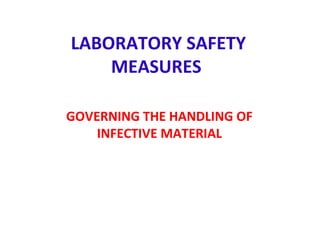
Dr.farouk practicals
- 1. LABORATORY SAFETY MEASURES GOVERNING THE HANDLING OF INFECTIVE MATERIAL
- 2. LABORATORY SAFETY MEASURES (1) • Coats, jackets, bags and other outer apparel should be left outside the laboratory. • Laboratory gowns must be worn inside the laboratory and not outside the lab. • Long hair should be tied back neatly and closed footwear should be worn. • NOTHING (fingers, pencils, pens) should be placed in the mouth. • Mouth pipetting is strictly forbidden in the laboratory. • No eating, drinking or smoking allowed in the laboratory. • The working bench should be wiped with disinfectant at the beginning and at the end of the laboratory session.
- 3. LABORATORY SAFETY MEASURES (2) • Every specimen must be regarded as dangerously infective and treated as such. • ALL ACCIDENTS such as spilling of infected material, cutting of fingers, or pricking of fingers, must be reported immediately to the laboratory instructor. • A spilled culture can be covered with paper towels and laboratory disinfectant poured over the towels and contaminated area; leave for 15 minutes before mopping up. DO NOT WIPE with coat, handkerchief or clothes. • All waste material must be placed in the special containers provided, and not thrown on to the floor.
- 4. LABORATORY SAFETY MEASURES (3) • Sharps (e.g., used needles and disposable syringes) should be discarded into special medical waste bins. • All used material (e.g., cover slips, slides, pipettes) must be placed in the containers provided containing disinfectant. • All discarded cultures must be placed in the bucket provided, ready for sterilization. • Do not discard any fluid into sinks or drains. Container will be provided to discard the fluid. • All instruments must be sterilized immediately after use (e.g., inoculating wire loop). • No slides or cultures are to be taken away from the lab. • Hands must be washed thoroughly before leaving the laboratory.
- 5. Infection in Microbiology Lab Infection in microbiology laboratories is generally caused by: Inhalation Inoculation Ingestion of microorganisms
- 6. Applications of Light Microscopy 1. Bright field microscope (uses light source) 2. Dark field microscope (with a special condenser and objective to illuminate organism against dark background) 3. Fluorescent microscope (specimen is stained with fluorescent dye that absorbs the energy of short light waves then releases light of longer wavelength) 4. Phase contrast microscope (uses a modified light microscope that permits greater contrast between substances of different thickness or density).
- 8. Light Microscope MICROSCOPE RULES When you have finished using your microscope 1. Remove slides from the stage. 2. Turn light source down to 0. 3. Clean objectives if using oil. 4. Switch off. 5. Leave lowest power objective (ie x4) in viewing position. 6. Put cover on. 7. Turn off at the power point.
- 9. DISINFECTION Students will test the efficacy of different disinfectants on Gram-negative bacteria using following method: 1. Take each of the following disinfectants in 5ml amounts into 3 sterile cotton plugged tubes as follows: A. Dishwasher detergent “DAC”. B. “Sekusept” disinfectant. C. 2% Glutaraldehyde buffered solution. 2. To each tube of disinfectant add 0.5ml of E.coli suspension. 3. Mix gently by tapping the bottom of the tubes. 4. Place the tubes in a 20°C water bath.
- 10. DISINFECTION 5. Transfer two loopful from each disinfectant bottle into a 5 ml sterile nutrient broth at intervals of 5 minutes, 10 minutes and 20 minutes. 6. Label the cultured broth tubes with time held in water bath. 7. Incubate the tubes for 48 hours at 37°C. 8. Record your results in the table provided as follows: Turbid Growth Disinfectant Time 5 mins 10 mins 20 mins Clear No growth A. Dishwasher “DAC” B. “Sekusept” C. 2% Glutaraldehyde
